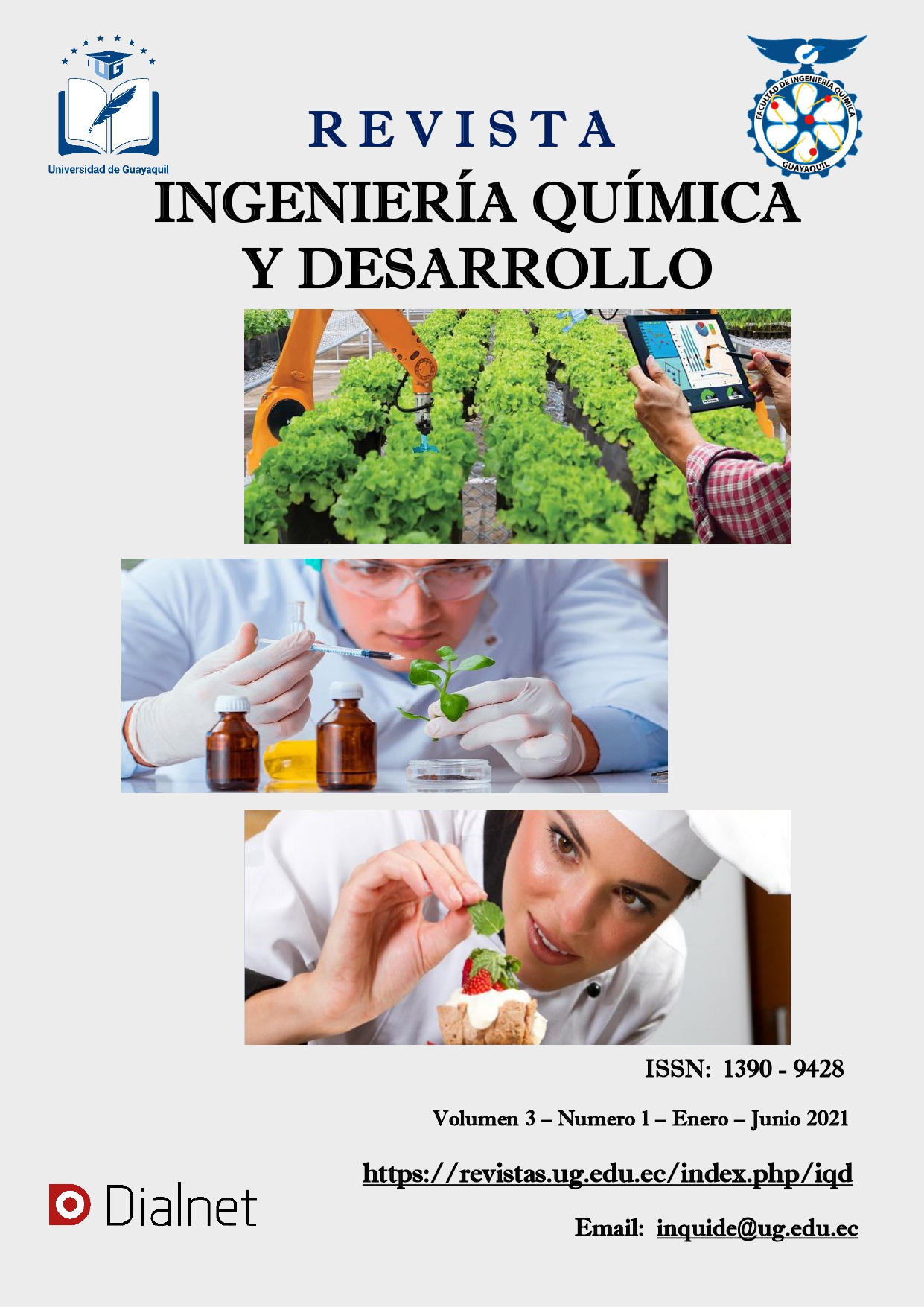Extracción y aplicación de aceites esenciales de la feijoa como conservante en la elaboración de embutidos de masa fina
Contenido principal del artículo
Resumen
En el presente trabajo se plantea realizar la extracción de aceites esenciales de la feijoa (Acca Sellowiana) para ser aplicados en la elaboración un embutido de pasta fina a manera de sustitución de los aditivos de origen químico, como son los nitritos, buscando así una opción libre de efectos secundarios. Dentro de nuestra investigación a través de diversas fuentes bibliográficas, se remarcan datos importantes acerca del origen de la feijoa, variedades, diferentes aplicaciones, composición nutricional y potencial capacidad antioxidante; así como también sobre los embutidos de pasta fina, su historia, ingredientes y métodos de preparación. Con esta información se procedió a realizar las respectivas pruebas de laboratorio descritas en las diferentes etapas de experimentación de este trabajo. Desde la extracción de los aceites esenciales, hasta, las diferentes formulaciones de mortadelas usando un porcentaje variable de aceites en cada muestra a valorar, también se realizaron pruebas de clasificación hedónicas con presencia de 70 jueces y finalmente pruebas de estimación de vida útil, tanto en ambiente controlado (en refrigeración a una temperatura estimada entre 0 – 4 °C) como en un ambiente no controlado (temperatura y humedad variable de la ciudad de Guayaquil). Dentro de los resultados obtenidos mediante las pruebas realizadas a las distintas muestras del embutido tipo mortadela los cuales fueron sometidos a varias formulaciones, usando distintos porcentajes de los aceites esenciales antes descritos, se concluyó que, de estas muestras, una, logro una aceptabilidad del 31.82%, tanto ante las pruebas hedónicas, como en las realizadas dentro de laboratorio. La formulación elaborada para la misma verifica que es una mortadela tipo I y cumple con todos los requisitos de las normas NTE INEN 1529-5, 1529-8, 1529-14 y 1529-15 confirmando así la completa inocuidad del producto, finalmente, en las pruebas de estimación de vida útil, se logró corroborar que los aceites de feijoa, cumplen con la función de conservante en los embutidos de pasta fina, mediante la comparación con otros productos de la misma clase, pero con una formulación química heterogénea a la descrita en nuestro trabajo.
Detalles del artículo
Sección

Esta obra está bajo una licencia internacional Creative Commons Atribución-NoComercial-SinDerivadas 4.0.
Cómo citar
Referencias
D. Cabrera, B. Begnale y C. Pritsch, «Procisur,» 2016. [En línea]. Available: http://www.procisur.org.uy/adjuntos/80ca732ba9b2_Guayabo-PROCISUR.pdf.
Y. Poodi, M. Bimakr, A. Ganjloo y S. Zarringhalami, «Intensification of bioactive compounds extraction from Feijoa (Feijoa sellowiana Berg.) leaves using ultrasonic waves.,» Food and Bioproducts Processing, pp. 37-50, 2018.
L. F. Rodríguez y L. T. Bermúdez, «Perfil y caracterización de la comercialización y consumo de la feijoa en Boyaca,» Agronomía Colombiana, pp. 56-62, 2017.
F. J. Peña y M. Cabezas, «Aspectos fisiológicos de la feijoa (Acca sellowiana berg) bajo condiciones de riego y déficit hídrico,» Revista U.D.C.A Actualidad & Divulgación Científica , pp. 381-390, 2014.
F. Zhu, «Chemical and biological properties of feijoa (Acca sellowiana),» Trends in Food Science & Technology, pp. 121-131, 2018.
J. P. Cavelier, M. Prada, P. Douat, N. Tobón, C. E. Martínez , P. Sagramoso, R. Jimenez, M. Florez, J. H. Pérez, J. Plata y F. Echeverria, «Colombia,» 28 Julio 2015. [En línea]. Available: http://www.colombiaexpomilan.co/info/conoce-colombia/tibasosa-el-pueblo-de-la-feijoa.html.
F. Oviedo, «Feijoa: 10 beneficios de un fruto que deberías conocer,» El ciudadano, 27 Abril 2015.
Martínez, Sulbarán de Ferrer, Ojeda de Rodríguez, Nava y Ferrer, «Actividad antibacteriana del aceite esencial de mandarina,» Revista de la Facultad de Agronomía, p. https://www.researchgate.net/profile/Alexis_Ferrer/publication/262737376_Actividad_antibacteriana_del_aceite_esencial_de_mandarina_Antibacterial_activity_of_mandarin_essential_oil/links/54d7965f0cf2970e4e747c20.pdf, 2018.
Naturaesen, Incubar y Sena, «Sena.edu,» Abril 2015. [En línea]. Available: http://www.med-informatica.net/TERAPEUTICA-STAR/AceitesEsencialesUdeA_esencias2001b.pdf?fbclid=IwAR3k1mwjXHDutbcKIZK849KZQZxF5Wi_tOPV5WjnpcDKkTzO9S3u7kzezuk.
P. Marful Rocha, «EIO.USC,» 2019. [En línea]. Available: http://eio.usc.es/pub/mte/descargas/ProyectosFinMaster/Proyecto_1673.pdf.
j. duque, p. lucas y j. marta, «los loros del libro,» vol. 4, nº 5, 2020.
b. v. rodolfo , i. i. susana y p. m. pedro, «papa pera tomate uva,» vol. 34, nº 6, 2021.
Infosalud. [En línea]. Available: https://www.infosalus.com/nutricion/noticia-reducir-consumo-embutido-relacion-cancer-20180217081434.html.
P. M. Martínez, «Adición de Portulaca oleracea L. a la alimentación de gallinas murcianas para la obtención de huevos enriquecidos,» Cartagena, 2015.
Sarmiento-Franco, L.A, «Portulaca oleracea,UN RECURSO VEGETAL VERSÁTIL EN ESPERA,» agro productividad volumen 9, pp. 62-63, 2016.
A. Di Benedetto,J. Molinari,C. Boschi,R. Klasman,D. Benedicto, «ADAPTACION DE CUATRO ESPECIES FLORALES ANUALES A DIFERENTES SUBSTRATOS DE CRECIMIENTO,» 31 07 2000. [En línea]. Available: http://revistas.uach.cl/index.php/agrosur/article/view/4009.
N. Moscuzza, «verdolaga una alternativa saludable,» 2016. [En línea]. Available: http://redi.ufasta.edu.ar:8080/xmlui/bitstream/handle/123456789/1271/2016_N_026.pdf?sequence=1.
E. f. a. y. nutricion, los carbohidratos en la nutricion humana, roma, 1997.
I. E. d. Normalización, «NTE INEN 1 313:99,» 20 02 1998. [En línea]. Available: https://181.112.149.204/buzon/normas/1313.pdf.
N. i. o. health, «U.S. Department of Health & Human Services,» 11 2018. [En línea]. Available: https://ods.od.nih.gov/factsheets/Omega3FattyAcids-DatosEnEspanol/.
Marcela Harris, Néstor Pellegrino,María Silvia Giacomino, Angel Chiesa , «COMPORTAMIENTO AGRONOMICO-PRODUCTIVO Y CONTENIDO DE ACIDOS GRASOS POLIINSATURADOS (OMEGA 3) DE Portulaca oleracea Y Montia perfoliata,» 2013. [En línea]. Available: https://www.researchgate.net/profile/Nestor_Pellegrino/publication/269403152_Comportamiento_agronomico_-_productivo_y_contenido_de_acidos_grasos_poliinsaturados_Omega_3_de_Portulaca_oleracea_y_Montia_perfoliata/links/55d3317808ae0b8f3ef925d5.pdf.
Dr. Ph. Dorosz, tabla de vitaminas sales minerales oligoelementos, paris: hispano europea, 2008.
C. R. M. Espin, 2015. [En línea]. Available: http://repositorio.puce.edu.ec/bitstream/handle/22000/9641/Tesis%20MBC%20Cristian%20Moncayo.pdf?sequence=1&isAllowed=y.
